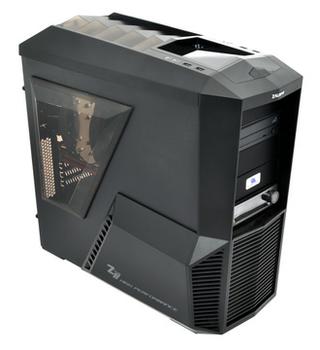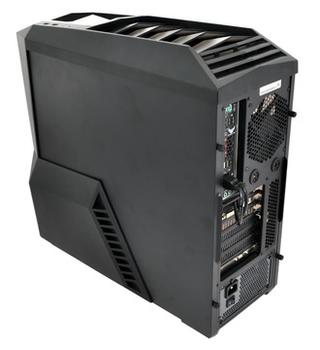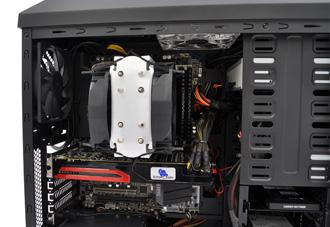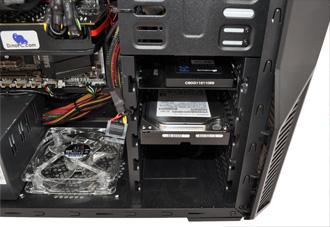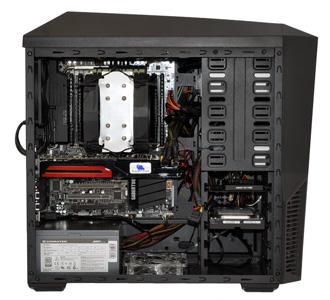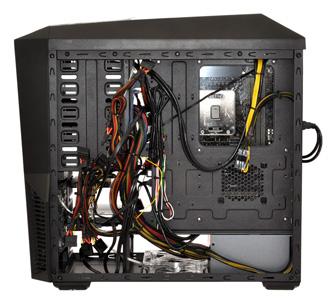Introduction
Hands up, how many of you have heard of DinoPC? We asked the same question in the HEXUS labs and a few hands weren't raised, so we're going by the assumption that the name will be new to some readers, too.
Launched in 2007, DinoPC was created to offer - in the company's own words - "a very user-friendly experience in buying a new customised computer."
"With a custom built PC from DinoPC you get much more than a beige box, we pride ourselves on providing service and support that receives regular praise and recommendations from our customers." And the mix of high-end solutions and reliable service appears to be working, as DinoPC is a name that now frequently pops up in conversation with some of the leading component manufacturers.
But shifting units is one thing, and building quality PCs is another, so to find out exactly what you get from a DinoPC, we're taking a look at one of the system integrator's latest introductions; the Raptor X79 OC.
A quick glance at the cutely-titled DinoPC Raptor intimates that this thing's going to be fast. It looks like a traditional gaming PC and the £1,349 price tag suggests that the high-end user is very much the target.
Our review sample, delivered by DinoPC's courier of choice Fedex, arrived safe and securely packaged in the original box, which itself sits in a larger box padded with air cushions. First impressions are good, but we were left slightly underwhelmed when we removed all the packaging as our sample system didn't look particularly clean - with dust and fingerprints being the main culprits.
Things can get messy when putting PCs together, but a rig that costs over £1,000 (or any amount for that matter) should be made to sparkle prior to shipping. Still, it's a formidable-looking thing, and that's largely thanks to the Zalman Z11 Plus chassis. The case is certainly an acquired taste, but if you like your PCs aggressive, this one will be right up your street. It has a total of seven fan mounts and a well-stocked front I/O panel that includes four USB ports (two of which are USB 3.0) and a pair of audio jacks.
On the inside, the base £1,349 specification provides a high-end ASUS Sabertooth X79 motherboard topped with an Intel Sandy Bridge Extreme Core i7-3820 processor (overclocked to 4.4GHz), a Xigmatek Prime SD1484 cooler and 8GB of Corsair Vengeance memory (4x2GB).
An excellent choice of components for a high-spec build and that trend is continued throughout. Graphics power is provided by a Radeon HD 7950, the system disk is a 60GB Corsair Force Series 3 SSD, a 1TB 7,200RPM Hitachi hard drive is installed as a secondary storage device, there's a DVD writer as standard and a 700W Xigmatek power supply provides the juice.
The default selection is strong, but we would chop and change a couple items; we'd upgrade to a larger 120GB solid-state boot device (it's worth the extra £55) and we'd probably opt to downgrade from the Sabertooth board to Gigabyte's X79-UD3. The ASUS board is lovely, but the downgrade allows you to double the size of the SSD and still save £14 on the total system cost.
It's also interesting to note that DinoPC's configuration options aren't as well stocked as you might expect. Whereas some system integrators offer a plethora of options for all components, DinoPC offers only a handful in each - there are three CPUs to choose from, three motherboards, three CPU coolers and just two memory configurations. Some might prefer more choice, but to DinoPC's credit, most of the available options are highly-rated products from big-name brands. Our one major criticism would be that the Raptor X79 OC can't be configured with the newly-released GeForce GTX 680, an oversight that we hope to see rectified sooner rather than later.
What we do like is that DinoPC has attempted to differentiate by throwing in a few unusual twists. The Raptor's standard configuration ensures that six of the chassis' seven fan mounts are occupied and there's a Zalman ZM-MFC3 fan controller installed in one of the front 5.25in drive bays. The latter is a particularly nice addition and features an FSTN display that shows temperature, fan speed for up to four fans, system up time and power consumption. Our sample sadly arrived with only one of four temperature sensors connected (to the GPU), but DinoPC tells us that all four would normally be hooked up.
The components are good, and the £1,349 price tag is almost exactly in line with what it would cost to buy the individual parts, but DinoPC's build quality could be neater. We've already commented on the dust (you can see it best in this picture) but cable management also leaves something to be desired. The use of a non-modular power supply in the default configuration doesn't help, but nonetheless, it's somewhat messier than we'd expected. So much so, that re-attaching the rear side panel is more challenging than it ought to be.
And there are ups and downs to DinoPC's standard three-year Platinum warranty, too. It's good in the sense that it includes excellent two-year cover for parts and three-years labour with unlimited repairs, but it's a return-to-base warranty and carriage costs are covered only for the first 30 days. If you have a problem with the PC after that initial month, you'll need to cover the cost of returning it to DinoPC's London office yourself or opt for the premium Gold warranty. Priced at an extra £149, the Gold upgrade includes parts, labour and free carriage for the full three years.
Build quality could have been tidier, but pricing is keen and the configuration is good. Let's find out how the Raptor performs.



